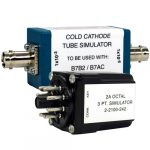Purpose
Simulators mimic the electrical signal from a typical vacuum gauge at various vacuum levels/pressures. Their most common use is troubleshooting vacuum systems and identifying potential setup issues. This application note outlines simulators offered by Televac® and how they can be used.
Simulator Types
Televac® offers simulators for many of our most popular vacuum sensors. These simulators come in two different types:
1. Zero point simulators simulate a typical vacuum gauge output at 0 micons/mTorr.
2. Multi-point simulators simulate a typical vacuum gauge output at multiple pressures.
Available simulators are listed below:
| Sensor Model | Simulated Pressures | Part Numbers |
| 2A Thermocouple | Zero (red line, 0 microns) 3 point (0, 100, 1000 microns) |
2-2100-237 2-2100-242 |
| 2A Mini Thermocouple | Zero (red line, 0 microns) 3 point (0, 100, 1000 microns) |
2-2100-240 2-2100-241 |
| 4A Convection | Zero (red line, 0 microns) 3 point (0, 1, 760 Torr) |
2-2119-000 2-2119-003 |
| 7B Penning Magnetron | 2 point (10-3, 10-5 Torr) 4 point (10-3, 10-4, 10-5, 10-6 Torr) |
2-2100-93 2-2100-108 |
| 7E Double Inverted Magnetron | 2 point (10-2, 10-5 Torr) | 2-2142-000 |
| 7F Double Inverted Magnetron | 2 point (10-3, 10-5 Torr) | 2-2145-000 |
Using Simulators to Troubleshoot
If the vacuum readings on your Televac® controller are incorrect, it can be challenging to determine which part of the setup is causing the issue. Several troubleshooting methods are described below:
1. Because a simulator represents the electrical signal from a typical vacuum gauge, it can be used to test whether the vacuum gauge is causing the problem. To test this, replace the vacuum gauge with a simulator and see if the outputs from the controller are within a reasonable tolerance. If they aren’t, the gauge may need to be replaced.
2. Almost all of our cold cathode gauges can be cleaned, which may fix any issues with those gauges. See Application Note 3002 (7B and 7E) and Application Note 3004 (7FC and 7FCS) for more information and the cleaning procedure.
3. If replacing the gauge doesn’t fix the problem, a simulator can also be used to test other system components without pulling vacuum. For example, a different cable can be tested by using it with the simulator to see if it fixes the problematic readings.
A Note on Using Simulators For Calibration
Calibration is a common step in the set up of a vacuum controller. It ensures that the controller readings with a corresponding vacuum gauge are in tolerance. Simulators don’t account for gauge to gauge variation because a simulator is representative of a typical vacuum gauge. Therefore, calibrating with a simulator can cause incorrect readings when a vacuum gauge is connected. Because of this, Televac® does not recommend attempting to calibrate a vacuum controller using a simulator.
For more information on Televac®’s recommended practices for field calibration of vacuum systems, please see Application Note 3015.
Related Products
• Sensor simulators are designed to electrically simulate Televac sensors at specific pressures. These units allow for simple troubleshooting of issues relating to cabling, sensors, and electronics.






